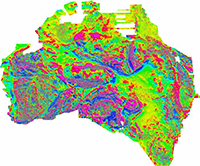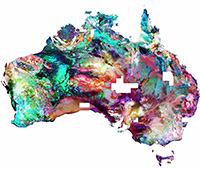News
Latest editions of Magnetic Anomaly Grid and Radiometric Map released
Published:17 February 2015
Australia will now be able to lay claim to the best geophysical data coverage of all the continents on Earth following the release of the sixth edition Total Magnetic Intensity (TMI) Anomaly Grid of Australia and the third edition Radiometric Map of Australia datasets.
The latest TMI grid of Australia now contains around 31.5 million line-kilometres of acquired magnetic survey data, which is 4.5 million more line-kilometres than the fifth edition released in 2010. The third edition of the Radiometric Map also fills substantial gaps in the data coverage of Queensland and Western Australia compared to the previous edition.
These magnetic and radiometric datasets are a compilation of numerous geophysical surveys conducted over more than 50 years by Geoscience Australia, the State and Territory Geological Surveys and industry.
These magnetic and radiometric data are fundamental datasets that improve understanding of the composition and structure of the geology of the continent. This contributes to the assessment of geological structure and mineral potential, paving the way for further exploration for mineral and energy resources.
Rocks are made up of different minerals and the magnetic properties of a rock depend on the amount and type of iron-rich minerals they contain. In particular, the magnetic iron mineral magnetite is found in small quantities throughout crustal rocks. Measuring magnetic variations of such minerals enables mapping of the distribution and patterns of magnetic rocks and hence mapping of the subsurface geology.
The latest TMI Anomaly Grid of Australia was also processed using a technique called Variable Reduction to Pole (VRTP), which makes adjustments to the location and shape of magnetic anomalies due to the variation in the inclination of the Earth's magnetic field with latitude. The VRTP process adjusts the magnetic anomalies so that simple features are mapped directly over the magnetic bodies. Without VRTP magnetic anomalies appear shifted relative to their true position.
The Radiometric Map of Australia dataset comprises grids of potassium, uranium and thorium element concentrations, and some derived products such as total dose and ratio grids. The radiometric, or gamma-ray spectrometric method is used to estimate concentrations of the naturally-occurring radioelements potassium, uranium and thorium by measuring the gamma-rays emitted from their radioactive decay. Changes in lithology, or soil type, are often accompanied by changes in the concentrations of these radioelements.
The datasets are available for free download from the Geophysical Archive Data Delivery System on the Australian Government Geoscience Portal. Note that because of file size limits, it is not possible for clients to download very large areas of the grid at full resolution. Clients wishing to do so should contact Geoscience Australia Client Services directly to make special arrangements.
Email:






